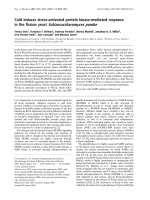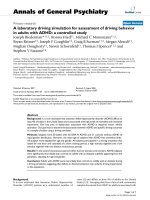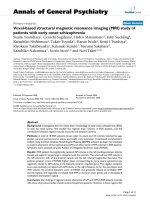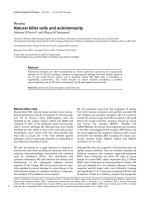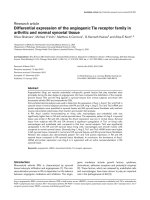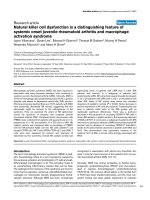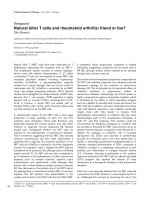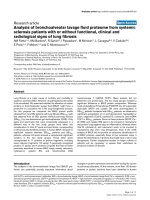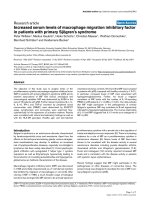Báo cáo y học: " Natural killer cells control a T-helper 1 response in patients with Behçet''''s disease" doc
Bạn đang xem bản rút gọn của tài liệu. Xem và tải ngay bản đầy đủ của tài liệu tại đây (1.1 MB, 9 trang )
Yamaguchi et al. Arthritis Research & Therapy 2010, 12:R80
/>Open Access
RESEARCH ARTICLE
© 2010 Yamaguchi et al.; licensee BioMed Central Ltd. This is an open access article distributed under the terms of the Creative Com-
mons Attribution License ( which permits unrestricted use, distribution, and reproduc-
tion in any medium, provided the original work is properly cited.
Research article
Natural killer cells control a T-helper 1 response in
patients with Behçet's disease
Yukie Yamaguchi
1,2
, Hayato Takahashi
3
, Takashi Satoh
1
, Yuka Okazaki
1
, Nobuhisa Mizuki
4
, Kazuo Takahashi
2
,
Zenro Ikezawa
2
and Masataka Kuwana*
1
Abstract
Introduction: Behçet's disease (BD) is a multisystem inflammatory disorder, in which a T-helper 1 (Th1)-polarized
immune response plays a major role in the pathogenic process. We evaluated the regulatory role of natural killer (NK)
cells in Th1-biased immune responses in patients with BD.
Methods: We studied 47 patients with BD, including 10 with active disease (aBD) and 37 with inactive disease (iBD),
and 29 healthy controls. The activation status and cytotoxic activity of NK cells were examined by flow cytometry. The
levels of mRNAs for immune modulatory and cytotoxic molecules in NK cells were determined by quantitative PCR.
The IL-12 signal strength in NK cells was determined by assessing the phosphorylation state of its downstream
component, signal transducer and activator of transduction 4, by immunoblotting. Finally, NK cells' ability to modulate
the Th1 response was evaluated by co-culturing NK cells and T cells without cell contact.
Results: CD69
+
-activated NK cells were significantly increased in aBD compared with iBD or control samples, although
their cytotoxic activities were similar. The iBD NK cells showed downregulated IL-12 receptor β
2
mRNA levels compared
with aBD or control NK cells. The increased IL-13 expression was detected in a subset of BD patients: most of them had
iBD. The IL-13 expression level in iBD patients was significantly higher than the level in controls, but was not statistically
different compared with the level in aBD patients. The gene expression profile in iBD patients was consistent with the
NK type 2 phenotype, and the shift to NK type 2 was associated with disease remission. NK cells from iBD patients
showed impaired IL-12-induced signal transducer and activator of transduction 4 phosphorylation. Finally, iBD, but not
control, NK cells suppressed IFNγ expression by aBD-derived CD4
+
T cells in vitro.
Conclusions: NK cells may control disease flare/remission in BD patients via NK type 2-mediated modulation of the
Th1 response.
Introduction
Behçet's disease (BD) is a multisystem inflammatory dis-
order characterized by recurrent attacks of uveitis, geni-
tal ulcers, oral aphtoid lesions, and skin lesions such as
erythema nodosum [1]. The etiology of BD remains
unclear, but previous studies on the circulating CD4
+
T
cells and affected lesions of BD patients with active dis-
ease showed elevated levels of T-helper 1 (Th1) cytok-
ines, such as IFNγ and IL-12, indicating that a Th1-
polarized immune response plays a major role in the
pathogenic process [2-4]. In addition, we recently
reported that cytotoxic lymphocytes, including CD8
+
and
γδ T cells, are also involved in the pathogenesis of BD via
their cytotoxic activity [5,6]. Natural killer (NK) cells are
another lymphocyte subset with cytotoxic activity, but
their reported numbers and cytotoxic activity in both cir-
culation and BD-associated lesions have been inconsis-
tent [7-9].
NK cells have long been regarded as an essential compo-
nent of innate immunity, based on their nonspecific cyto-
toxic activity against virus-infected and tumor cells [10].
Recent evidence, however, indicates that NK cells also
regulate innate and acquired immune responses through
their secretion of soluble factors and/or cell-cell contact
[11]. Recently, a classification of NK cells into two func-
tional subsets based on their expression profiles of cytok-
* Correspondence:
1
Division of Rheumatology, Department of Internal Medicine, Keio University
School of Medicine, 35 Shinanomachi, Shinjuku-ku, Tokyo 160-8582, Japan
Full list of author information is available at the end of the article
Yamaguchi et al. Arthritis Research & Therapy 2010, 12:R80
/>Page 2 of 9
ines and cytokine receptors has gained wide acceptance
[12]: NK type 1 (NK1) cells mainly produce IFNγ and IL-
10, and express high levels of IL-12 receptor β
2
(IL-
12Rβ
2
); while NK type 2 (NK2) cells produce IL-5 and/or
IL-13, and express low levels of IL-12Rβ
2
. This NK1/NK2
paradigm has been shown to control pathogenic Th1-
biased or Th2-biased immune response in several human
immune-mediated diseases, such as multiple sclerosis
[13], asthma [14], and pemphigus vulgaris [15].
In the present study, we investigated the potential regula-
tory functions of NK cells in the Th1-biased environment
of BD by evaluating their activation status, gene expres-
sion profiles, and functional properties in association
with the disease status.
Materials and methods
Patients and controls
We studied 47 patients with BD (19 men and 28 women,
aged 47.3 ± 17.6 years) who fulfilled the criteria proposed
by an International Study Group [16]. Twenty-nine
healthy individuals (14 men and 15 women, aged 38.2 ±
12.3 years) provided control samples.
The BD of the patients was classified as active (aBD) in 10
cases and inactive (iBD) in 37 cases at the time of blood
sampling. Active disease was defined as flare of charac-
teristic BD symptoms, including severe skin, mucosal,
and/or ocular involvement that required introduction or
increase of systemic corticosteroids (≥ 0.5 mg/kg),
cyclosporine, and/or infliximab [6]. Five patients who had
aBD at their first examination were re-evaluated after
their BD-related symptoms resolved.
All samples were obtained after the patients and control
subjects gave their written informed consent, approved
by the International Review Boards of Keio University
and Yokohama City University.
HLA-B51 typing
The presence or absence of HLA-B51 was determined by
PCR of the genomic DNA using sequence-specific prim-
ers and sequence-based typing [17].
Cell preparations
Peripheral blood mononuclear cells (PBMCs) were iso-
lated from heparinized venous blood by Lymphoprep
(Fresenius Kabi Norge AS, Oslo, Norway) density-gradi-
ent centrifugation. NK cells were purified by the MACS
cell isolation system (Miltenyi Biotec, Bergisch Gladbach,
Germany) as CD14
-
CD3
-
CD56
+
cells [15]. Namely, the
CD14
+
cells and CD3
+
cells were depleted from PBMCs
by incubation with anti-CD14 and anti-CD3 mAb-cou-
pled magnetic beads, and then the CD56
+
cells were posi-
tively selected by incubation with anti-CD56 mAb-
coupled magnetic beads, according to the manufacturer's
protocol. The sorted fraction contained >99.6 ± 0.2%
CD56
+
cells, and contamination with CD3
+
cells was <0.3
± 0.3%. In some experiments, T cells were also isolated as
CD56
-
CD3
+
cells using the MACS cell isolation system.
Activated status of natural killer cells
PBMCs were incubated with the following combination
of fluorescently labeled mAbs: anti-CD56-fluorescein
isothiocyanate, anti-CD69-phycoerythrin-cyanin 5.1, and
anti-CD3-allophycocyanin (Beckman-Coulter, Fullerton,
CA, USA). Fluorescent cell staining was detected by a
FACSCalibur
®
flow cytometer (Becton Dickinson, San
Jose, CA, USA) using CellQuest™ software. Appropriate
fluorescently labeled isotype-matched mAbs to irrelevant
antigens were used in all analyses. The proportion of acti-
vated NK cells was assessed from the cells expressing
CD69, an early activation marker of lymphocytes [18],
within the CD56
+
CD3
-
NK cell fraction.
Cytotoxic activity
The nonspecific cytotoxic activity of NK cells was quanti-
fied by a flow cytometry-based assay using NKTEST
®
(Orpegen Pharma, Heidelberg, Germany). Briefly, K562
target cells pre-stained with a lipophilic green fluorescent
membrane dye were mixed with freshly isolated effector
PBMCs at an effector-to-target ratio of 25:1 and were
incubated for 2 hours at 37° C. Dead cells were detected
by incubation with a DNA staining solution and subse-
quent analysis on a flow cytometer. The specific cytotox-
icity (%) was determined by subtracting the proportion of
dead cells in the mock-treated sample from the propor-
tion in the sample pre-treated with effector cells.
Expression of genes associated with NK1/NK2 phenotype
and cytotoxicity
The total RNA was extracted from MACS-sorted NK
cells using an RNeasy
®
mini kit (Qiagen, Hilden, Ger-
many), and was subjected to oligo (dT)-primed reverse
transcription to generate first-strand cDNA. The cDNA
equivalent to 5 ng total RNA was subjected to semiquan-
titative PCR to detect IL-12Rβ2, IFNγ, IL-5, IL-10, IL-13,
perforin, granzyme B, and glyceraldehyde-3-phosphate
dehydrogenase (GAPDH), using specific primer sets as
described elsewhere [15]. The PCR products were frac-
tionated on agarose gels and visualized by ethidium bro-
mide staining. The intensity of individual bands was
semiquantitatively analyzed using the Image/J
®
software
[19]. The relative expression level of individual genes was
normalized to the expression of GAPDH.
The mRNA expression of selected genes was further eval-
uated using a quantitative Taqman
®
real-time PCR system
(Applied Biosystems, Foster City, CA, USA). All primers
and probes were purchased from Applied Biosystems.
The gene expression was standardized based on serial
amounts of cDNA prepared from a healthy donor's
Yamaguchi et al. Arthritis Research & Therapy 2010, 12:R80
/>Page 3 of 9
PBMCs that were stimulated with phorbol 12-myristate-
13-acetate and ionomycin [15]. The relative expression
levels of individual genes were normalized to the expres-
sion level of GAPDH.
Phosphorylation status of signal transducer and activator
of transduction 4
The phosphorylated signal transducer and activator of
transduction 4 (Stat4) and total Stat4 in IL-12-stimulated
NK cells was detected by immunoblots as previously
described [15]. The antibodies used were rabbit anti-
phosphorylated-Stat4 polyclonal antibodies (Zymed Lab-
oratories, South San Francisco, CA, USA) and rabbit anti-
Stat4 polyclonal antibodies (Santa Cruz Biotechnology,
Santa Cruz, CA, USA). The intensity of individual bands
with the expected molecular sizes was semiquantitatively
analyzed using the image/J
®
software. The phosphoryla-
tion status of Stat4 was expressed as the ratio of the inten-
sity of phosphorylated Stat4 to that of total Stat4.
IFNγ expression in CD4+ T cells co-cultured with natural
killer cells
The capacity of NK cells to modulate the expression of
IFNγ by T cells was evaluated using a cell-contact-free
co-culture system. Briefly, MACS-sorted T cells (2 × 10
6
)
obtained from aBD patients were cultured in RPMI1640
supplemented with 7.5% low IgG fetal bovine serum
(HyClone, South Logan, UT, USA) with or without sorted
NK cells (5 × 10
5
) prepared from iBD patients or healthy
controls, applied to the upper chamber of an insert sepa-
rated by a 0.4 μm pore-size membrane (BD Biosciences,
San Jose, CA, USA) on 12-well plastic plates, for 12 hours
at 37°C. Leukocyte Activation Cocktail
®
(5 μl/well; BD
Biosciences) was added at the initiation of the culture.
The T cells were then fixed and permeabilized using an
Intracellular Cytokine Staining Kit Human
®
(BD Biosci-
ences), and were subsequently stained with anti-IFNγ-
phycoerythrin (BD Biosciences) and anti-CD4-phyco-
erythrin-cyanin 5.1 (Beckman-Coulter), according to the
manufacturer's protocols. The appropriate fluorescently
labeled control antibodies were used to define the back-
ground Immunofluorescence of the cells. Finally, the cells
were subjected to flow cytometry, and the IFNγ expres-
sion level on the gated CD4
+
T cells was calculated as a
mean fluorescence intensity using CellQuest™ software.
The relative IFNγ expression was calculated as the ratio
of IFNγ expression by CD4
+
T cells cultured with NK
cells to the expression by CD4
+
T cells cultured alone.
Statistical analysis
All results are expressed as the mean ± standard devia-
tion. Statistical comparisons between two groups were
performed using the Mann-Whitney U test. Serial mea-
surements were statistically evaluated by the Wilcoxon t
test.
Results
Clinical features of Behçet's disease patients
Of 47 patients with BD, 100%, 61%, 96%, and 28% had had
oral ulcer, uveitis, skin lesion, and genital ulcer, respec-
tively, during the course of the disease. Only a small pro-
portion of the patients had history of intestinal (6%),
vascular (11%), and neurological (6%) involvement. HLA-
B51 was detected in 28 patients (60%). Treatment at the
time of blood sampling included colchicine (n = 13), low-
dose prednisolone (n = 3), cyclosporine (n = 2), etaner-
cept (n = 1), colchicine and low-dose prednisolone (n =
4), low-dose prednisolone and methotrexate (n = 1),
colchicine, low-dose prednisolone and cyclosporine (n =
1), colchicine, low-dose prednisolone and azathioprine (n
= 1), and colchicine, low-dose prednisolone and inflix-
imab (n = 1). Twenty patients (42%) received no treat-
ment.
Ten patients (21%) were classified as having aBD at the
time of blood sampling, based on a major uveitis attack (n
= 7), intestinal flare with a minor uveitis attack (n = 2), or
exacerbation of mucocutaneous symptoms with high
fever (n = 1). None of the aBD patients had concomitant
flare of vascular or neurological involvement. There was
no difference in the frequency of HLA-B51 or treatment
regimens between aBD and iBD. Seven patients with
uveitis attack were treated with infliximab (n = 4),
cyclosporine (n = 1), or an increased dosage of predniso-
lone in combination with cyclosporine (n = 2), resulting
in resolution of symptoms within 3 months. Two patients
with intestinal flare were treated with infliximab, result-
ing in resolution of all intestinal symptoms within 3
months. The mucocutaneous flare in the remaining
patient was improved by high-dose prednisolone in com-
bination with an increase in the dosage of cyclosporine.
Activation status of natural killer cells
We determined the activation status of the circulating NK
cells in seven patients with aBD, 22 patients with iBD, and
19 healthy controls by examining the CD69 expression on
the NK cells. As shown in Figure 1, the proportion of
CD69
+
-activated NK cells was significantly greater in the
aBD patients than in the iBD patients or healthy controls
(P = 0.01 and P = 0.003, respectively). There was a trend
toward an increased proportion of activated NK cells in
the iBD patients compared with in healthy controls, but
the difference did not reach statistical significance (P =
0.1). These findings indicate that in vivo activation of cir-
culating NK cells is observed in patients with aBD, but is
not remarkable in those with iBD.
Yamaguchi et al. Arthritis Research & Therapy 2010, 12:R80
/>Page 4 of 9
Cytotoxic activity of natural killer cells
There was no difference in the nonspecific cytotoxic
activity among the NK cells from three patients with aBD,
10 patients with iBD, and 13 healthy controls (14.9 ±
10.3%, 14.3 ± 5.4%, and 14.4 ± 7.4%, respectively).
Gene expression profiles of natural killer cells
NK cells freshly isolated from aBD patients, iBD patients,
and healthy controls were first subjected to semiquantita-
tive PCR to measure the expression of genes associated
with NK1/NK2 differentiation and cytotoxicity, including
those encoding IL-12Rβ2, IL-5, IL-10, IL-13, IFNγ, perfo-
rin, and granzyme B. Of these molecules, the mRNA lev-
els of IL-12Rβ2, perforin, and granzyme B were
significantly lower, and that of IL-13 was significantly
higher, in the iBD patients than in the aBD patients or
healthy controls (P <0.05 for all comparisons) (data not
shown). No IL-5 expression was detected in any of the
samples from BD patients or healthy controls, and there
was no statistically significant difference in the expres-
sion level of IL-10 or IFNγ.
To confirm the results obtained by semiquantitative PCR,
the gene expression levels of IL-12Rβ2, IL-13, perforin,
and granzyme B were further evaluated by quantitative
TaqMan
®
real-time PCR (Figure 2). The IL-12Rβ2 expres-
sion was significantly lower in the iBD patients than in
the aBD patients or healthy controls (P = 0.006 and P =
0.0002, respectively). The increased IL-13 expression was
detected in a subset of patients with BD: most of them
had iBD. The IL-13 expression level in iBD patients was
significantly higher than the level in the healthy controls
(P = 0.04), and tended to be higher than the level in aBD
patients (P = 0.2). Interestingly, differences in IL-12Rβ2
and IL-13 levels were not detectable between the aBD
patients and healthy controls.
These findings indicated that the NK cells from iBD
patients have a gene expression profile compatible with
NK2; that is, upregulated IL-13 and downregulated IL-
Figure 1 Activation status of natural killer cells in Behçet's disease. Proportion of activated natural killer (NK) cells in active Behçet's disease (aBD)
patients, inactive Behçet's disease (iBD) patients, and healthy controls. (a) Representative dot-plot analysis for the expression of CD69 and CD56 in the
gated CD3
-
lymphocytes from a patient with aBD, a patient with iBD, and a healthy control. The numbers indicate the proportion of CD69
+
-activated
cells in total NK cells. (b) Proportion of CD69
+
-activated NK cells in seven aBD patients, 22 iBD patients, and 19 healthy controls. Horizontal bars, mean
values. NS, not significant.
Yamaguchi et al. Arthritis Research & Therapy 2010, 12:R80
/>Page 5 of 9
Figure 2 Gene expression levels of natural killer cells in Behçet's disease. Gene expression levels of (a) interleukin-12 receptor β
2
(IL-12Rβ2), (b)
IL-13, (c) perforin, and (d) granzyme B in natural killer (NK) cells from active Behçet's disease patients (aBD), inactive Behçet's disease (iBD) patients,
and healthy controls. The IL-12Rβ2, IL-13, perforin, and granzyme B expression levels in the NK cells were evaluated using semiquantitative PCR: two
representative images each from aBD patients, iBD patients, and healthy controls are shown in the upper portion of each panel. The relative gene
expression levels were further determined by quantitative Taqman
®
real-time PCR in 10 aBD patients, 37 iBD patients, and 29 healthy controls: results
are shown in the lower portion of each panel. Horizontal bars, mean values. GADPH, glyceraldehyde-3-phosphate dehydrogenase; NS, not significant.
Yamaguchi et al. Arthritis Research & Therapy 2010, 12:R80
/>Page 6 of 9
12Rβ2. On the other hand, the expression levels of perfo-
rin and granzyme B were significantly lower in the iBD
patients than in the aBD patients or healthy controls (P
<0.02 for all comparisons), while these expression levels
were similar between these aBD patients and healthy con-
trols.
Serial gene expression analysis of natural killer cells
For five aBD patients, additional blood samples were
available when their BD symptoms were resolved after
the introduction of infliximab (n = 2) or cyclosporine (n =
1), or of an increased dosage of prednisolone in combina-
tion with cyclosporine (n = 2). The gene expression level
of IL-12Rβ2 was reduced in all five patients as the disease
status became quiescent (P = 0.04) (Figure 3). IL-13
expression became detectable in three of the patients,
and the change was borderline but did not reach a statis-
tical significance (P = 0.05). These results strongly sug-
gest that an NK2 shift was associated with disease
remission. In addition, the expression level of perforin
was reduced when the patients' disease status changed to
remission (P = 0.02).
Impaired IL-12 signaling in natural killer cells from inactive
Behçet's disease patients
The downregulated IL-12Rβ
2
gene expression observed
in the NK cells from iBD patients could lead to impaired
IL-12 signaling. To test this possibility, the phosphoryla-
tion status of Stat4, which is a downstream component of
the IL-12 signaling pathway [20], was evaluated in the NK
cells from six iBD patients and five healthy controls. As
shown in Figure 4, the IL-12-induced Stat4 phosphoryla-
tion was significantly lower in the iBD patients than in
the healthy controls (P = 0.02).
Capacity of natural killer cells from inactive Behçet's
disease patients to suppress IFNγ expression by Th1 cells
The NK2 bias observed in patients with iBD led us to
speculate that NK cells play a role in controlling the
pathogenic Th1 response in BD patients. To evaluate this
hypothesis, the NK cells from iBD patients or healthy
controls were co-cultured with Th1 cells derived from
aBD patients in a cell-contact-free system. The intracellu-
lar IFNγ expression in the gated CD4
+
T cells was then
analyzed using flow cytometry (Figure 5). We found that
the level of IFNγ expressed by Th1 cells was reduced after
Figure 3 Serial gene expression measurements of natural killer
cells in active Behçet's disease. Serial gene expression measure-
ments of interleukin-12 receptor β
2
(IL-12Rβ2), IL-13, perforin, and
granzyme B in natural killer (NK) cells from patients with active Behçet's
disease at the first evaluation. The relative gene expression levels in NK
cells were determined by quantitative PCR in samples obtained at the
time of active disease and at a follow-up visit during remission. NS, not
significant.
Figure 4 IL-12 signaling of natural killer cells in inactive Behçet's
disease patients. IL-12-induced signal transducer and activator of
transduction 4 (Stat4) phosphorylation in natural killer (NK) cells from
inactive Behçet's disease (iBD) patients and healthy controls. (a) NK
cells from six iBD patients and five healthy controls were stimulated
with IL-12, and were subjected to immunoblotting for the detection of
phosphorylated Stat4 (pStat4) and total Stat4. (b) Phosphorylation sta-
tus of Stat4, which is expressed as the ratio of the intensity of pStat4 to
that of total Stat4, in NK cells from six iBD patients and five healthy con-
trols. Horizontal bars, mean values.
Yamaguchi et al. Arthritis Research & Therapy 2010, 12:R80
/>Page 7 of 9
their co-culture with the NK cells derived from iBD
patients. In fact, the relative IFNγ expression level was
significantly lower in the Th1 cells co-cultured with iBD
patients' NK cells compared with the level in those co-
cultured with healthy controls' NK cells (P = 0.02). These
findings suggest that the NK2 cells from iBD patients can
suppress the Th1 response in aBD patients without cog-
nate cell-cell contact.
Discussion
The present study has shown that the NK cells were phe-
notypically altered in BD patients, especially those in
inactive disease status. Features of the circulating NK
cells in iBD patients included: downregulated gene
expression of IL-12Rβ
2
; upregulated gene expression of
IL-13 in a subset of the patients; downregulated perforin
and granzyme B gene levels; and impaired IL-12-induced
Stat4 phosphorylation. Upregulated IL-13 and downreg-
ulated IL-12Rβ2 observed in NK cells from iBD patients
were compatible with the NK2 phenotype. A serial NK
phenotype analysis in aBD patients supported the associ-
ation between NK2 bias and inactive disease status. Fur-
thermore, NK2 cells obtained from iBD patients directly
suppressed the IFNγ expression of Th1 cells derived from
aBD patients in vitro. These findings together suggest
that the NK1/NK2 balance modulates disease flare/
remission in BD patients by controlling the pathogenic
Th1 response. This situation is analogous to multiple
sclerosis, another Th1-mediated disease, in which NK2
bias is associated with disease remission [13].
A major limitation of this study is the small number of
patients analyzed, especially those with aBD. During 2
years of the study period, only 10 patients with aBD were
enrolled in two major university hospitals in the Tokyo
metropolitan area. In addition, there was a limited chance
of obtaining peripheral blood samples from patients with
aBD, because such patients required immediate introduc-
tion of treatment. Further multicenter studies involving a
large number of patients with aBD are necessary to con-
firm our findings. Another limitation is the difficulty in
classifying BD patients into those with active disease and
those with inactive disease. We used a strict definition to
select patients with aBD: flare of characteristic BD symp-
toms that required introduction of the intensive treat-
ment, such as high-dose corticosteroids, cyclosporine,
and infliximab. Patients with mild mucocutaneous mani-
festations or minor uveitis attack, which did not require
intensive therapy, were therefore classified as having iBD.
This clinical heterogeneity in the iBD subset may result in
variability in the gene and protein expression profiles.
Additional analysis according to individual clinical mani-
festations and/or treatment regimens would clarify these
issues, but again the number of patients enrolled was too
small to conduct subanalysis. Finally, we should recognize
Figure 5 Natural killer cell suppression of IFNγ expression by T-
helper 1 cells in inactive Behçet's disease. Suppression of IFNγ ex-
pression in T-helper 1 (Th1) cells by cell-contact-free co-culture with
natural killer (NK) type 2 cells from inactive Behçet's disease (iBD) pa-
tients. T cells from active Behçet's disease patients were cultured alone
or in combination with NK cells from healthy controls or iBD patients,
and the IFNγ expression level in the CD4
+
T cells was evaluated using
flow cytometry. (a) Representative histogram plots showing expres-
sion of IFNγ on gated CD4
+
T cells that were cultured alone, or with NK
cells from an iBD patient or a healthy control. Vertical line in each his-
togram indicates the median. (b) IFNγ expression levels in Th1 cells cul-
tured with the NK cells from six iBD patients or from five healthy
controls. Relative IFNγ expression level calculated as the ratio of IFNγ
expression by CD4
+
T cells cultured with NK cells to the expression by
CD4
+
T cells cultured alone. Horizontal bars, mean values.
Yamaguchi et al. Arthritis Research & Therapy 2010, 12:R80
/>Page 8 of 9
that a series of experiments involved only a subset of the
patients and controls, which potentially bias the results.
Our results suggest that the NK2 cells in iBD patients can
suppress the Th1 response through at least two distinct
mechanisms. First, the NK2 cells in iBD patients were
intrinsically hyporesponsive to IL-12 due to their down-
regulated expression of IL-12Rβ
2
and impaired IL-12 sig-
naling, resulting in deficient IFNγ production even in the
Th1 environment. Second, the NK2 cells from iBD
patients actively suppressed IFNγ expression in aBD-
derived Th1 cells. A similar inhibitory effect of human
NK2 cells on the production of IFNγ by T cells was also
reported for healthy individuals' NK cells that were
induced to express the NK2 phenotype [13], and for NK2
cells obtained from multiple sclerosis patients in remis-
sion [21]. Taken together, the NK cells and T cells - two
major IFNγ producers - were deficient in IFNγ produc-
tion in the NK2-biased immune environment observed in
iBD patients.
How the NK2 cells from iBD patients suppress the IFNγ
expression in Th1 cells, however, remains unclear. One
potential soluble mediator in our cell-contact-free culture
system is IL-13, a typical T-helper 2 cytokine that inhibits
Th1 responses in vitro and in vivo [22,23], although
upregulated IL-13 expression was detected only in one-
third of the iBD patients. In addition, this IL-13-mediated
inhibitory effect is reported to occur predominantly
through the modulation of antigen-presenting cells rather
than as a direct effect on T cells [22]. Additional soluble
factors secreted from NK2 cells are likely to be involved
in this regulation, but the NK cells from iBD patients did
not express IL-5, which plays a primary role in Th1 inhi-
bition in multiple sclerosis patients in remission [13].
Furthermore, it has been reported that NK cells modulate
Th1 responses also by interacting directly with T cells, B
cells, and dendritic cells though cognate cell-cell contact
[24,25].
Perforin and granzyme B, major cytoplasmic granule tox-
ins, were downregulated in the NK cells from patients
with iBD. Interestingly, this gene expression profile is
analogous to that of the NK cells in patients with active
pemphigus vulgaris, who also show NK2 bias [15]. This
phenomenon could be explained by the reduced IL-12Rβ
2
expression and impaired IL-12 signaling, but the cyto-
toxic activity was the same among the NK cells of iBD
patients, aBD patients, and healthy controls. The reason
for this inconsistency is unknown, but the cytotoxic
activity of NK cells might be regulated by more compli-
cated mechanisms, involving a balance between activat-
ing and inhibitory NK receptors, as well as the expression
of the ligands for death receptors on target cells [26].
In aBD patients, the proportion of activated NK cells in
the circulation was markedly increased. This is reason-
able because IL-12 can activate NK cells in the Th1 envi-
ronment, even though the nonspecific cytotoxic activity
and gene expression profiles were similar between the
NK cells from aBD patients and healthy controls. These
activated NK cells would migrate to sites of inflammation
and contribute to the ongoing tissue damage in aBD
patients, but this appears to be just a bystander effect of
the Th1 environment of aBD.
Conclusions
The present study is the first demonstrating a novel regu-
latory role for NK cells in the pathogenic process of BD.
Our results have suggested that NK cells are actively
involved in the induction and maintenance of disease
remission in BD patients, through NK2 polarization.
Future studies aimed at elucidating the mechanisms that
control the NK1/NK2 paradigm in BD patients may be
useful for developing new NK cell-targeted therapeutic
strategies for BD.
Abbreviations
aBD: active Behçet's disease; BD: Behçet's disease; GAPDH: glyceraldehyde-3-
phosphate dehydrogenase; iBD: inactive Behçet's disease; IFN: interferon; IL:
interleukin; IL-12Rβ
2
: interleukin-12 receptor β
2
; mAb: monoclonal antibody;
NK: natural killer; NK1: natural killer type 1; NK2: natural killer type 2; PBMC:
peripheral blood mononuclear cell; PCR: polymerase-chain reaction; Stat4: sig-
nal transducer and activator of transduction 4; Th1: T-helper 1.
Competing interests
The authors declare that they have no competing interests.
Authors' contributions
YY performed the acquisition of data, and analysis and interpretation of the
data, and wrote the manuscript. HT made a substantial contribution to the
acquisition of data. TS and YO performed the acquisition of data. NM, KT, and ZI
provided peripheral blood samples and clinical information, and performed
analysis of the data. MK designed the experiments, performed data analysis
and interpretation, and wrote the manuscript. All authors read and approved
the final manuscript.
Acknowledgements
The authors thank Aya Komori for their excellent technical assistance. The pres-
ent work was supported by a research grant for intractable diseases from the
Japanese Ministry of Health, Labour and Welfare (to MK).
Author Details
1
Division of Rheumatology, Department of Internal Medicine, Keio University
School of Medicine, 35 Shinanomachi, Shinjuku-ku, Tokyo 160-8582, Japan,
2
Department of Environmental Immuno-Dermatology, Yokohama City
University Graduate School of Medicine, 3-9 Fukuura, Kanazawa-ku, Yokohama
236-0004, Japan,
3
Department of Dermatology, Keio University School of
Medicine, 35 Shinanomachi, Shinjuku-ku, Tokyo 160-8582, Japan and
4
Department of Ophthalmology, Yokohama City University Graduate School of
Medicine, 3-9 Fukuura, Kanazawa-ku, Yokohama 236-0004, Japan
References
1. Sakane T, Takeno M, Suzuki N, Inaba G: Behçet's disease. N Engl J Med
1999, 341:1284-1291.
2. Ben Ahmed M, Houman H, Miled M, Dellagi K, Louzir : Involvement of
chemokines and Th1 cytokines in the pathogenesis of mucocutaneous
lesions of Behçet's disease. Arthritis Rheum 2004, 50:2291-2295.
Received: 21 July 2009 Revised: 22 December 2009
Accepted: 11 May 2010 Published: 11 May 2010
This article is available from: 2010 Yamaguchi et al.; licensee BioMed Central Ltd. This is an open access article distributed under the terms of the Creative Commons A ttribution License ( which permits unrestricted use, distribution, and reproduction in any medium, provided the original work is properly cited.Arthritis R esearch & Thera py 2010, 12:R80
Yamaguchi et al. Arthritis Research & Therapy 2010, 12:R80
/>Page 9 of 9
3. Frassanito MA, Dammacco R, Cafforio P, Dammacco F: Th1 polarization of
the immune response in Behçet's disease: a putative pathogenetic role
of interleukin-12. Arthritis Rheum 1999, 42:1967-1974.
4. Imamura Y, Kurokawa MS, Yoshikawa H, Nara K, Takada E, Masuda C,
Tsukikawa S, Ozaki S, Matsuda T, Suzuki N: Involvement of Th1 cells and
heat shock protein 60 in the pathogenesis of intestinal Behcet's
disease. Clin Exp Immunol 2005, 139:371-378.
5. Yasuoka H, Okazaki Y, Kawakami Y, Hirakata M, Inoko H, Ikeda Y, Kuwana
M: Autoreactive CD8
+
cytotoxic T lymphocytes to major
histocompatibility complex class I chain-related gene A in patients
with Behçet's disease. Arthritis Rheum 2004, 50:3658-3662.
6. Yasuoka H, Yamaguchi Y, Mizuki N, Nishida T, Kawakami Y, Kuwana M:
Preferential activation of circulating CD8
+
and γδ T cells in patients
with active Behçet's disease and HLA-B51. Clin Exp Rheumatol 2008,
26:S59-S63.
7. Suzuki Y, Hoshi K, Matsuda T, Mizushima Y: Increased peripheral blood
γδ
+
T cells and natural killer cells in Behçet's disease. J Rheumatol 1992,
19:588-592.
8. Kaneko F, Takahashi Y, Muramatsu R, Adachi K, Miura Y, Nakane A,
Minagawa T: Natural killer cell numbers and function in peripheral
lymphoid cells in Behcet's disease. Br J Dermatol 1985, 113:313-318.
9. Hamzaoui K, Ayed K, Hamza M, Touraine JL: Natural killer cells in Behcet's
disease. Clin Exp Immunol 1988, 71:126-131.
10. Hamerman JA, Ogasawara K, Lanier LL: NK cells in innate immunity. Curr
Opin Immunol 2005, 17:29-35.
11. Zhang C, Zhang J, Tian Z: The regulatory effect of natural killer cells: do
'NK-reg cells' exist? Cell Mol Immunol 2006, 3:241-254.
12. Peritt D, Robertson S, Gri G, Showe L, Aste-Amezaga M, Trinchieri G:
Differentiation of human NK cells into NK1 and NK2 subsets. J Immunol
1998, 161:5821-5824.
13. Takahashi K, Miyake S, Kondo T, Terao K, Hatakenaka M, Hashimoto S,
Yamamura T: Natural killer type 2 bias in remission of multiple sclerosis.
J Clin Invest 2001, 107:R23-R29.
14. Wei H, Zhang J, Xiao W, Feng J, Sun R, Tian Z: Involvement of human
natural killer cells in asthma pathogenesis: natural killer 2 cells in type
2 cytokine predominance. J Allergy Clin Immunol 2005, 115:841-847.
15. Takahashi H, Amagai M, Tanikawa A, Suzuki S, Ikeda Y, Nishikawa T,
Kawakami Y, Kuwana M: T helper type 2-biased natural killer cell
phenotype in patients with pemphigus vulgaris. J Invest Dermatol 2007,
127:324-330.
16. International Study Group for Behçet's Disease: Criteria for diagnosis of
Behçet's disease. Lancet 1990, 335:1078-1080.
17. Mizuki N, Ohno S, Ando H, Chen L, Palimeris GD, Stavropoulos-Ghiokas E,
Ishihara M, Goto K, Nakamura S, Shindo Y, Isobe K, Ito N, Inoko H: A strong
association of HLA-B*5101 with Behçet's disease in Greek patients.
Tissue Antigens 1997, 50:57-60.
18. López-Cebrera M, Santis AG, Fernández-Ruiz E, Blacher R, Esch F, Sánchez-
Mateos P, Sánchez-Madrid F: Molecular cloning, expression, and
chromosomal localization of the human earliest lymphocyte activation
antigen AIM/CD69, a new member of the C-type animal lectin
superfamily of signal-transmitting receptors. J Exp Med 1993,
178:537-547.
19. Image/J
®
software [ />20. Chua AO, Wilkinson VL, Presky DH, Gubler U: Cloning and
characterization of a mouse IL-12 receptor-beta component. J
Immunol 1995, 155:4286-4294.
21. Takahashi K, Aranami T, Endoh M, Miyake S, Yamamura T: The regulatory
role of natural killer cells in multiple sclerosis. Brain 2004,
127:1917-1927.
22. Young DA, Lowe LD, Booth SS, Whitters MJ, Nicholson L, Kuchroo VK,
Collins M: IL-4, IL-10, IL-13, and TGF-β from an altered peptide ligand-
specific Th2 cell clone down-regulate adoptive transfer of
experimental autoimmune encephalomyelitis. J Immunol 2000,
164:3563-3572.
23. Loza MJ, Peters SP, Zangrilli JG, Perussia B: Distinction between IL-13
+
and IFN-γ
+
natural killer cells and regulation of their pool size by IL-4.
Eur J Immunol 2002, 32:413-423.
24. Mailliard RB, Son YI, Redlinger R, Coates PT, Giermasz A, Morel PA, Storkus
WJ, Kalinski P: Dendritic cells mediate NK cell help for Th1 and CTL
responses: two-signal requirement for the induction of NK cell helper
function. J Immunol 2003, 171:2366-2373.
25. Zingoni A, Sornasse T, Cocks BG, Tanaka Y, Santani A, Lanier LL: NK cell
regulation of T cell-mediated responses. Mol Immunol 2005,
42:451-454.
26. Smyth MJ, Cretney E, Kelly JM, Westwood JA, Street SE, Yagita H, Takeda K,
van Dommelen SL, Degli-Esposti MA, Hayakawa Y: Activation of NK cell
cytotoxicity. Mol Immunol 2005, 42:501-510.
doi: 10.1186/ar3005
Cite this article as: Yamaguchi et al., Natural killer cells control a T-helper 1
response in patients with Behçet's disease Arthritis Research & Therapy 2010,
12:R80
